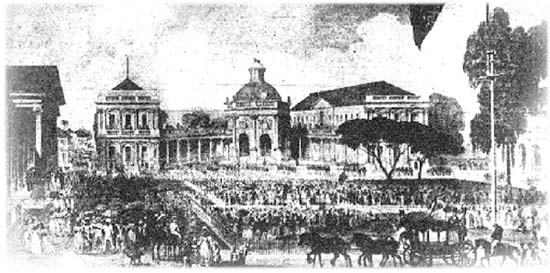Jamaica

In Jane Eyre, Jane often refers to a feeling of servitude and submissiveness when succumbing to the will of predominantly male charters in the text. When she is unsure or willing to give in to her perceived masters, her ties to Jamaica often free her of the bondage that she fears. This is evident in three different times of the text. The first is the acknowledgment of Jane's uncle when Mrs. Reed dies. The second is the appearance of Mr. Briggs, who stops the wedding between Jane and Mr. Rochester, and the third is receiving the news of her uncle's death and the accompanying money of her inheritance. All these instances represent a breaking point from Jane's perceived oppressors. For example, when Jane Receives the news of her inheritance, she says, "And then this money came only to me: not to me and a rejoicing family, but to my isolated self. It was a grand boon doubtless; and independence would be glorious – yes, I felt – that thought swelled my heart" (Bronte 341). Here Bronte explicitly tells the reader of the freedom that Jane now feels with as due to her money, she won't have to be reliant on anyone.
The island of Jamaica was first settled around 600 C.E by the Taino Indians, and the leading economy of the island was agriculture and fishing (Buisseret, David J, et al. para 2). In 1494 Christopher Columbus would "discover" Jamaica, and as a reward from the Spanish government given ownership of the island (“The History of Jamaica” para 6). It wasn't until 1509, fifteen years after Columbus's discovery the Spanish government started settling the island. At this time, Jamaica's economy began shifting away from agriculture and fishing to the trade of animal hides and food. It was also roughly around this time when Spanish settlements started to enslave the Taino Indians and import enslaved people to the island (Buisseret, David J, et al. para 3). For about the next one hundred and fifty years, The Spanish controlled the island struggling to make it profitable. Then in 1655, the British attacked and gained control of the island. During the fighting with the Spanish many of the enslaved islanders escaped into the Jamaican wilderness, where they built their settlements and were labeled as Marrons (“The History of Jamaica” para 12). After the British seized control of Jamaica, their fighting with the Spanish did not end until 1670 with the signing of the Madrid treaty. Shortly after, in 1672, the British slave trade formed, and Jamaica became one of the world's largest slave and sugar markets and became one of the most profitable colonies for the British government (Buisseret, David J, et al. para 6). Soon the slave population of the island was five times greater than the European population on the island and soon brought about a great deal of civil unrest. And would be the cause of two wars, the first won by the Maroons in 1739 and the second won by the British in 1797. In 1782, a French fleet began attacking the island backed by the Spanish in between the two wars (Buisseret, David J, et al. para 7). However, the British were able to retain control of the island. Soon after, the British abolished the transatlantic slave trade in 1807, which increased the production cost of sugar (Buisseret, David J, et al. para 9). Then in 1831- 1832, Among the rising cost to produce sugar and civil unrest, several black leaders rose and tried to lead rebellions against the British but were swiftly dealt with. Soon after the revolts, the British began to blame the missionaries for inciting the civil unease and began attacking Baptist and Methodist churches (Buisseret, David J, et al. para 8). Then in 1838, the price of sugar began to drop, and the British emancipated the enslaved Jamaicans. The next one- hundred years for Jamaica were fraught with power struggles until they received their independence from the British government in 1944 (“The History of Jamaica” para 15 ).
Given Jamaica's long history of slavery and its role in the British empire and the eventual emancipation of the enslaved Jamaicans taken place in 1838, nine years before the publication of Jane Eyre, it is possible Bronte would have been influenced by the events taking place in Jamaica during the writing of Jane Eyre. It would also make sense why Bronte uses Jamaica as a device for Jane's own independence as the connection between the emancipation of the enslaved people and the hope of freedom for woman servitude.
Works Cited
Brontë Charlotte, and Deborah Lutz. Jane Eyre. W.W. Norton and Company, 2016.
Buisseret, David J, et al. “British Rule.” Encyclopædia Britannica, Encyclopædia Britannica, Inc., https://www.britannica.com/place/Jamaica/British-rule.
“The History of Jamaica.” Jamaica Information Service, https://jis.gov.jm/information/jamaican-history/.
Tortello, Rebecca. “ The Road To Freedom.” A Special Gleaner Feature on Pieces of the Past - the Road to Freedom -the First 500 Years in Jamaica, https://old.jamaica-gleaner.com/pages/history/story006.html.
Coordinates
Longitude: -77.297508000000
